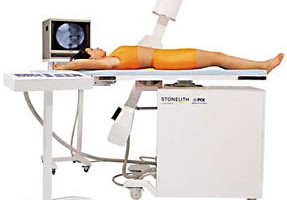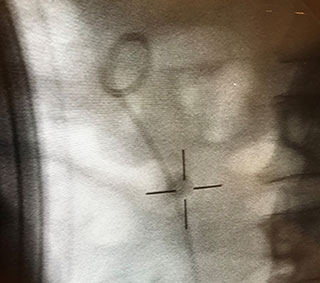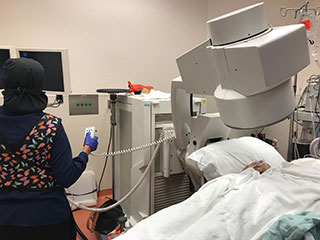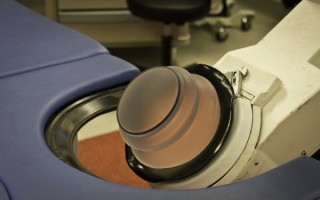
Extracorporeal Shockwave Lithotripsy, “ESWL” for short, was developed in the 1980′s. It works by using sound waves to break kidney stones. It is the least invasive stone surgery.
What it involves?
Patients lay on their back on a special operating table. After sedation, an gel apparatus that looks like a giant breast implant (see second photo) is placed against the patient’s back side on the site where the kidney stone is present. Loud and powerful sound waves are then produced by various methods, depending on machine type.
We used to have patients inside a large pool of water, but switched to a more convenient gel-based media to transmit the sound waves.

The challenge then is to use the ESWL machine’s X-Rays to identify and target the sound waves onto the stone. On average, 2,000 shock waves are then delivered to the stone and “treatment success” during the operation is noted when a sharply denoted stone at the beginning of treatment on X-Ray is more “fuzzy” or hazy towards the end.
Obviously, the hard part for some patient comes AFTER the treatment, when these fragments have to actually pass.
Thus, our clinical experience and research recommends this treatment to patients with smaller stones (<1cm) so that the fragments after ESWL would be small enough to pass easily.
In those patients who have larger stones or several stones that are targeted with ESWL, we typically recommend placing a stent (a plastic tube resembling a straw) to help prevent the kidney from becoming blocked while the stone fragments are passing down and out.
Placing a stent requires a urologist to look inside the bladder with a cystoscope (camera).

After treatment is complete, patients are awaken and taken to the recovery area. A couple of hours of observation are typical afterwards. Patients are expected to have pain that is normally eased with tablet pain medications.
This surgery is normally done in the outpatient setting and thus patients are sent home same day unless there are other health problems that require an admission to the hospital.
Length of Surgery
Typically less than one hour, but may be longer depending on how long it takes to sedate a patient, how well the stone is targeted and whether a stent needs to be placed. Like a lot of things in surgery, the actual treatment is quick, but the setup in the OR, patient positioning, sedation and preparation takes often more time than expected.

Anesthesia
May be done with moderate sedation General anesthesia (heavy sedation with a ventilator) is recommended for best results. With general anesthesia, we are able to control patient’s breathing and thus allow for better targeting of the stone.
Benefits
- Least invasive kidney stone surgery
- Go home same day
- No skin incisions
- Works well with smaller stones
- Least painful in most cases
- Least potential damage to the urinary tract from instrumentation
Acute Risks
- <10% Risk of “Steinstrasse” (stone fragments scattered and blocking the tube that drains the kidney)
- <1% Severe urine infection requiring hospitalization
- Incomplete stone fragmentation
- Incomplete passage of stone fragments
- 5-30% Kidney bleeding (from mild bruising from small vessel to large vessel bleeding from the shockwave forces)
- Flank (back) pain
- Blood in the urine is very common and resolves within the first 24 hours
- <1% Risk of injury to organs next to the kidney (i.e. pancreas, intestines)
Chronic Risks
- Risk of developing high blood pressure (hypertension)
- Further stone production
- Patients with baseline renal dysfunction may be at risk for further renal damage from shockwaves
- Incomplete passage of stone fragments
- Kidney bleeding (bruising from small vessel or large vessel bleeding from the shockwave forces)

